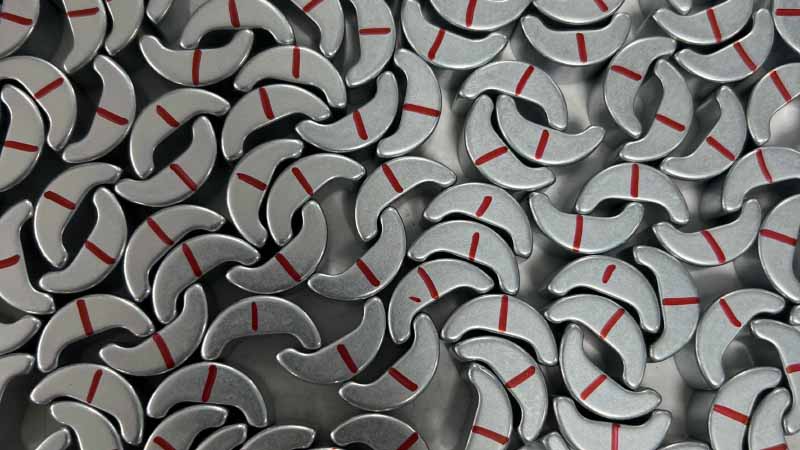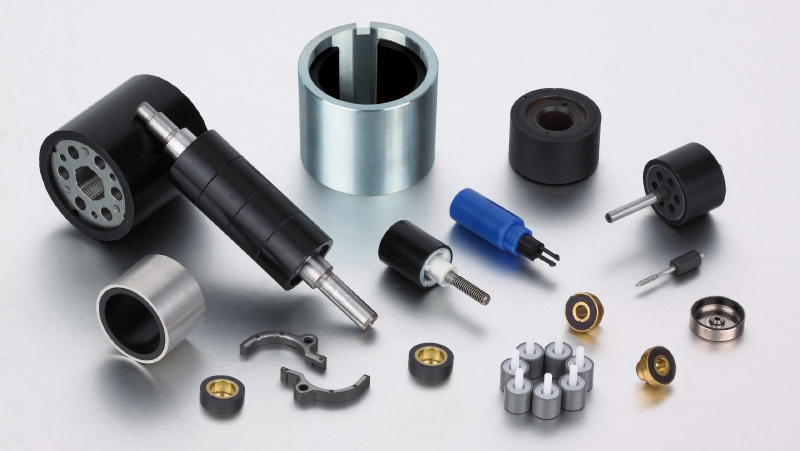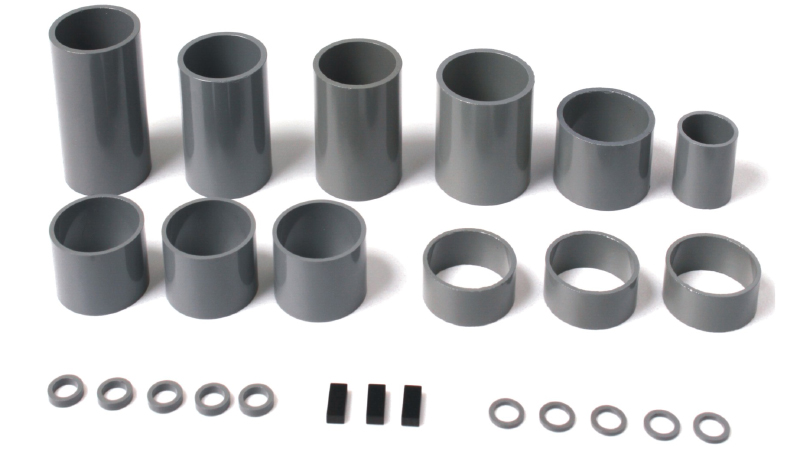Neodymium magnets, also called NdFeB magnets, are rare earth magnets, the strongest type of permanent magnet currently available.
They are made from an alloy of neodymium (Nd), iron (Fe), and boron (B) and are known for their high magnetic field strength and the ability to produce a strong magnetic field even at a small size.
Neodymium magnets are often classified into three main categories based on their manufacturing process: sintered, bonded, and hot-pressed NdFeB magnets.

Sintered NdFeB Magnet
These magnets are made by sintering, heating, and pressing a mixture of neodymium, iron, and boron powders until they form a solid. This is the most common method for producing neodymium magnets, as it allows for a high degree of precision and control over the final shape and properties of the magnet.
sintered NdFeB magnets are used in applications where high strength and durability are important, such as motors and generators.
Pros of Sintered NdFeB magnets:
- Extremely high magnetic performance (currently the largest magnetic material with the largest magnetic energy product up to 55MGOe)
- It can be adapted to high-temperature working environments by adding dysprosium and terbium to improve intrinsic coercivity and working temperature.
Cons of Sintered NdFeB magnets:
- The addition of dysprosium and terbium increases the unit cost of the product.
- Making sintered NdFeB magnets is complex, resulting in high processing losses.
- The yield of sintered NdFeB magnets can be affected by the complexity of the manufacturing process.
Bonded Neodymium Magnet
These magnets are made by mixing neodymium, iron, and boron powders with a polymer binder, then molding and curing the mixture to form a solid magnet. This method allows for a wide range of shapes and sizes to be produced, but the magnets are typically not as strong as sintered neodymium magnets.

Bonded NdFeB magnets are used in applications where cost is a primary concern.
Pros of Bonded NdFeB magnets:
- High dimensional accuracy and flexible shape.
- It does not require the addition of rare earth elements, resulting in a lower unit cost than Sintered NdFeB magnets.
- Directly formed, resulting in low processing losses.
Cons of Bonded NdFeB magnets:
- Lower magnetic performance than sintered NdFeB magnets (maximum magnetic energy product of about 12MGOe)
- Low intrinsic coercivity and working temperature limit their applications.
Hot-pressed Neodymium Magnet
A hot-pressed neodymium magnet is a type of neodymium iron boron (NdFeB) magnet made using a manufacturing process called hot pressing. In this process, neodymium, iron, and boron powders are mixed and placed in a mold. The mold is then heated to a high temperature, and pressure is applied to compress the powders into the desired shape.
Hot-pressed NdFeB magnets are particularly useful in applications such as motors, where high strength and durability are important

Some potential advantages of hot-pressed NdFeB magnets include the following:
Pros of Hot-pressed NdFeB magnets:
- High magnetic properties (maximum magnetic energy product of 43MGOe)
- Hot-pressed NdFeB magnets are made in a single-forming process. They have a stable structure that is less prone to cracking or breaking under stress. They are particularly well-suited for use in electric motors.
Cons of Hot-pressed NdFeB magnets:
- Limited to making only ring shapes, limiting their applications
- High technical barriers and patent limitations make them expensive. Due to the high cost of the process and the fact that patents protect the technology, only a few companies, such as GM, Daido, and Delta, currently have the technology to produce neodymium magnets through hot pressing. So far, Daido is the only producer known for its ability to mass-produce hot-pressed neodymium magnets.
Below is the standard comparison of the magnetic properties among three types of NdFeB magnets:
| NdFeB Magnet Types | Max Energy Product/KOe | Intrinsic Coercive/KOe | Remanence/kGs | Max Working Temperature |
| Sintered | 33-55 | 12-35 | 11-15 | 200°C |
| Bonded | 6-12 | 7-18 | 6-8 | 160°C |
| Hot-pressed | 28-43 | 10-25 | 12-14 | 200°C |
Application Difference:
Neodymium magnets are available in various forms: sintered, bonded, and hot-pressed. Each of these magnets has unique characteristics and is suitable for different applications. As a result, their applications do not overlap, and each type of magnet is used in specific areas where its characteristics are best suited.
Hot-pressed neodymium magnets are known for their high magnetic strength and are used in a variety of applications. Still, they are typically more expensive to produce than sintered or bonded magnets and are used in applications where high magnetic performance is required. They are also limited to being made into ring shapes, which limits their scope of use. Currently, they are mainly used in the automotive EPS motor field.
Sintered neodymium magnets are the most widely used type of magnet due to their high magnetic strength and versatility. They are used in various applications, including motors, generators, sensors, and speakers.
Bonded neodymium magnets are typically less expensive to produce than sintered magnets and are often used in applications where cost is a primary concern. However, they are generally not as strong as sintered magnets and may not be suitable for applications that require high magnetic performance. They are mainly used in hard drive spindle motors and small power micro motors.
Conclusion
The choice between sintered, bonded, and hot-pressed NdFeB magnets will depend on the application’s specific requirements. Each magnet type has unique properties and advantages, and the best choice will depend on the application’s specific needs.
